Swallowtail Caterpillar
Some species of swallowtail caterpillars have brightly colored eye-like spots on their bodies to mimic the eyes of a much larger predator, scaring off potential attackers.
Advertisement
Swallowtail Caterpillar Scientific Classification
Read our Complete Guide to Classification of Animals.
Swallowtail Caterpillar Conservation Status
Swallowtail Caterpillar Facts
- Prey
- Plant leaves
- Main Prey
- The leaves from plants in the Apiaceae family, including fennel, parsley, and dill.
- Name Of Young
- N/A
- Group Behavior
- Solitary
- Fun Fact
- Some species of swallowtail caterpillars have brightly colored eye-like spots on their bodies to mimic the eyes of a much larger predator, scaring off potential attackers.
- Estimated Population Size
- Undetermined
- Biggest Threat
- Habitat destruction
- Most Distinctive Feature
- colorful striped body
- Distinctive Feature
- eyespots
- Other Name(s)
- N/A
- Gestation Period
- 10-14 days
- Temperament
- docile, solitary
- Wingspan
- N/A
- Training
- N/A
- Optimum pH Level
- N/A
- Incubation Period
- N/A
- Age Of Independence
- birth
- Age Of Fledgling
- N/A
- Average Spawn Size
- N/A
- Litter Size
- N/A
- Habitat
- Swallowtail caterpillars live n a variety of different habitats, including meadows, forests, and gardens.
- Predators
- Birds, lizards, chipmunks, squirrels
- Diet
- Herbivore
- Average Litter Size
- N/A
- Lifestyle
- Diurnal
- Solitary
- Favorite Food
- The leaves from plants in the Apiaceae family, including fennel, parsley, and dill.
- Type
- Papilionidae
- Common Name
- Swallowtail caterpillar
- Special Features
- brightly colored eye-like spots on their bodies to mimic the eyes of a much larger predator, scaring off potential attackers.
- Origin
- undetermined
- Location
- Globally, except for Antarctica
- Slogan
- N/A
- Group
- N/A
- Nesting Location
- N/A
- Age of Molting
- 2-3 weeks
Swallowtail Caterpillar Physical Characteristics
- Color
- Brown
- Yellow
- Black
- White
- Green
- Skin Type
- Exoskeleton
- Lifespan
- 1- 4 weeks
- Weight
- undeternmined
- Height
- 0.25-0.5 inches
- Length
- 1-3 inches
- Age of Sexual Maturity
- N/A
- Age of Weaning
- N/A
- Venomous
- No
- Aggression
- Low
View all of the Swallowtail Caterpillar images!
With almost 600 different species of swallowtail butterflies, it would follow that there are almost 600 different species of swallowtail caterpillars. It’s true! And North America is home to about 40 of them! Swallowtail caterpillars are the larval stage of swallowtail butterflies. They feed on a variety of plants, including fennel, dill, and parsley. Their soft bodies come in various colors and patterns. They typically eat a lot of plant matter and grow rapidly before spinning a chrysalis and entering the pupal stage. They emerge from the chrysalis as adult butterflies. Keep reading to learn more about these fascinating creatures.
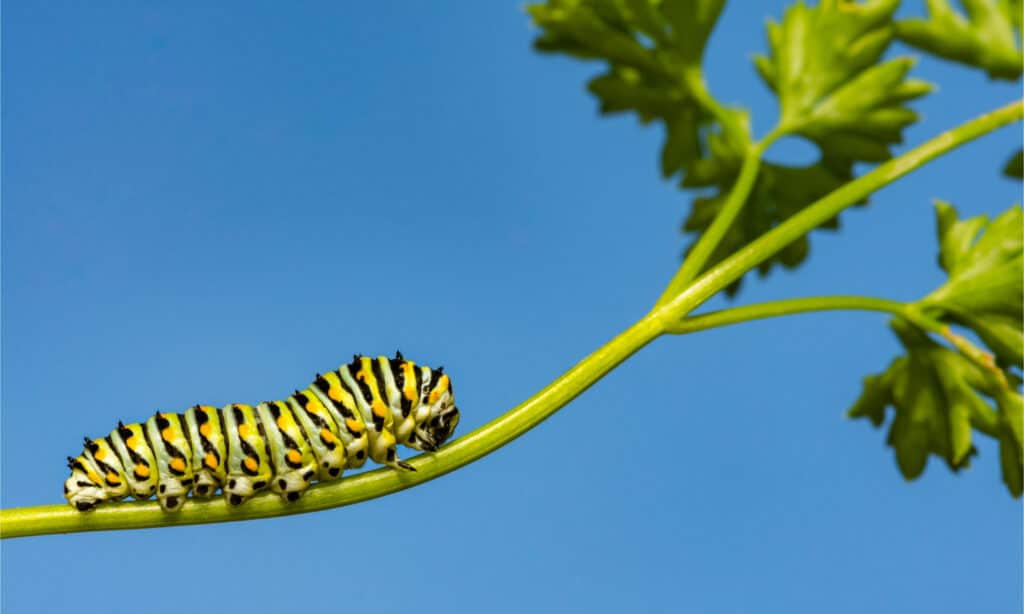
Swallowtail caterpillars are the larval stage of swallowtail butterflies.
©Jay Ondreicka/Shutterstock.com
Five Fabulous Facts about Swallowtail Caterpillars
- Swallowtail caterpillars have unique scent glands that secrete a foul-smelling liquid to deter predators.
- The caterpillars can make a clicking noise with their mandibles to further deter predators.
- Swallowtail caterpillars have a false head on the back end of their body to fool predators into attacking the wrong end.
- The caterpillars have a symbiotic relationship with ants, which protects them from predators in exchange for a sweet secretion from the caterpillars.
- Some species have brightly colored, eye-like spots on their bodies to mimic the eyes of a much larger predator, scaring off potential attackers
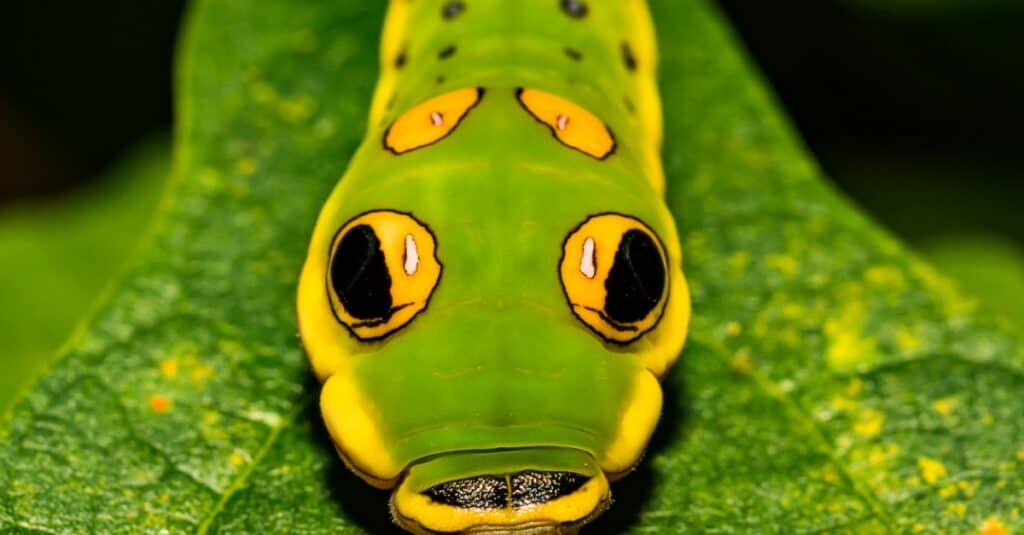
Some species of swallowtail caterpillars, like this spicebush swallowtail caterpillar, have brightly colored, eye-like spots on their bodies to mimic the eyes of a much larger predator, scaring off potential attackers.
©iStock.com/JasonOndreicka
Scientific Name
The scientific name for the swallowtail caterpillar, Papilionidae, is the same as the scientific name for the swallowtail butterfly. Papilionidae is Latin for butterfly.
Appearance and Behavior
Swallowtail caterpillars are known for their distinctive, colorful appearance and their defensive behavior. Swallowtail caterpillars are slender and cylindrical with a distinct head and body. These colorful insects are typically green, yellow, black, or brown in color. Some species are brightly striped. Their plump, segmented bodies are divided into the head, the thorax, and the abdomen. with small, black or yellow spots. Like the insects that they are, swallowtail caterpillars have six legs, three pairs on each side of their body. The legs have hairy tufts at the end.
They use their legs to detect food, predators, and other swallowtails using chemoreceptors. Chemoreceptors are sensory cells that detect and respond to chemical signals. Chemoreceptors are located on the feet. They detect and locate food sources, as well as detect potential predators or mates. These receptors allow the caterpillar to locate and identify plants that are suitable for feeding, and to avoid those that are toxic or unpalatable.
The body has three parts: the head, the thorax, and the abdomen. The head is responsible for food intake and sensory input. The thorax is the middle section of the caterpillar, located between its head and its abdomen. It acts as an anchor for the caterpillar’s legs. The abdomen is where digestion, respiration, and excretion occur. Mature caterpillars measure from 3 to 6 inches in length. Their body width is usually half their length. Female and male larvae are about the same size.
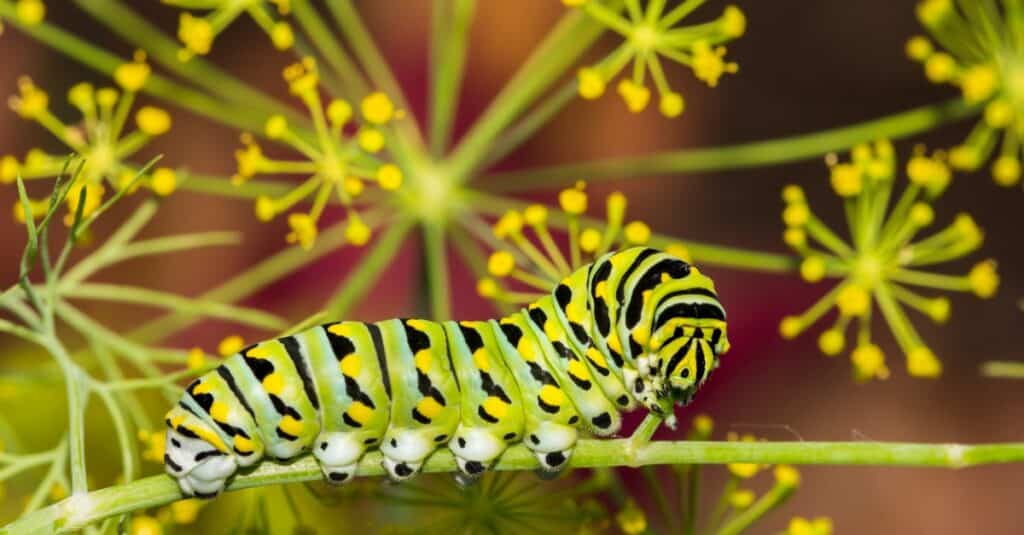
Swallowtail caterpillars are known for their distinctive, colorful appearance and their defensive behavior.
©Jay Ondreicka/Shutterstock.com
Behavior
When threatened, Swallowtail caterpillars will often rear up and display brightly colored spots or eyespots on their bodies to deter predators. Predators see the large spots and erroneously believe that they are staring down a much larger animal. Eastern swallowtail caterpillars have decoy eyespots. They also have orange horns that they can extend when they sense danger. Swallowtail caterpillars have the ability to secrete a repugnant-smelling liquid as a defense mechanism. Most species are armed with osmeterium, scent glands that secrete a substance that has a most unpleasant odor when they feel threatened. The repulsive odor repels would-be predators.
Swallowtail caterpillars are active during the day, feeding on leaves and growing rapidly. They are solitary creatures. Such is the life of the caterpillar. The origin of the swallowtail caterpillar, as well as the swallowtail butterfly, is not specified or known. It is a species that has evolved over millions of years.
Swallowtail Caterpillar Habitat
Swallowtail caterpillars live on every continent and every country around the globe with the exception of Antarctica. They live in a variety of habitats including forests, meadows, and gardens. Swallowtails are decidedly less evident in arid, desert regions. They feed on the leaves of plants in the parsley family, such as dill, fennel, and wild carrot. Some species have specific habitat requirements, such as the Eastern Tiger Swallowtail, which is commonly found in deciduous woodlands.

Habitat destruction is the leading cause of swallowtail decline worldwide.
©Rich Carey/Shutterstock.com
Predators and Threats
Swallowtail caterpillars have a variety of predators. Predation by birds, parasitic wasps, and other insects, as well as exposure to pesticides and habitat destruction all pose threats to swallowtail caterpillars. Some species also have specific plant species that they rely on for food, so a loss of those plants can also be a threat to the caterpillars. Climate change can also affect the timing of their life cycle and the availability of food, as well.
Conservation Status
The conversation status varies among species. The Schaus’ swallowtail butterfly (Heraclides aristodemus ponceanus), for example, is listed as an endangered species in the U.S.. The Eastern tiger swallowtail’s(Papilio glaucus) conservation status, however, is classified as one of least concern.Habitat destruction is the leading cause of swallowtail decline worldwide. As their natural habitats are destroyed or fragmented, the availability of food plants for the caterpillars is reduced. This can lead to population declines, as well as increased competition for resources among the remaining caterpillars. Additionally, the loss of natural habitats can also lead to increased exposure to predators, further exacerbating the decline in population. Conservation efforts, such as habitat restoration and protection, are crucial for protecting these insects and their habitats
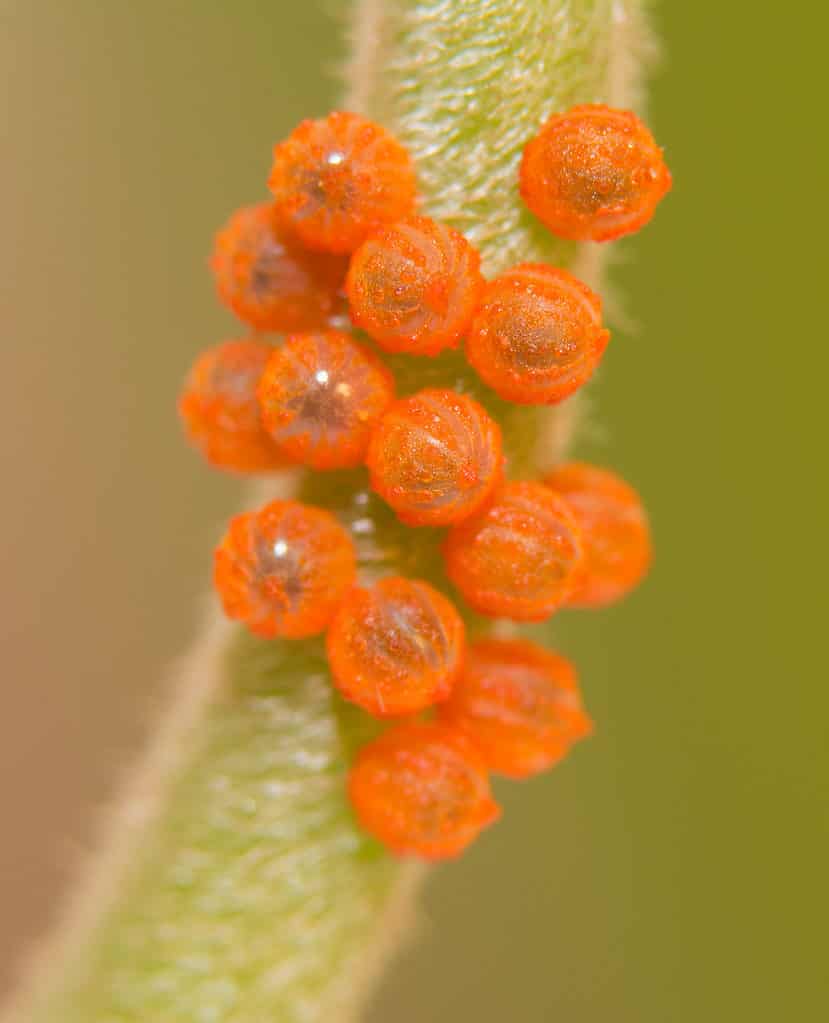
Swallowtail caterpillars emerge from eggs in 10-14 days.
©Sari ONeal/Shutterstock.com
Swallowtail Caterpillar: Lifecycle
The lifecycle of a swallowtail caterpillar, also known as the larval stage, typically lasts for about four weeks. The process begins with the laying of eggs by the adult female swallowtail butterfly. The caterpillars will feed off of the host plants after they hatch. The eggs hatch into small, black and green striped caterpillars that feed on the leaves of fennel, dill, and parsley, as well as other plants in the Apiaceae family.
As they grow, they molt or shed their skin several times. After the final molt, the caterpillar forms a chrysalis which hangs from a twig or leaf. Inside the chrysalis, the caterpillar becomes a pupa before undergoing metamorphosis and emerging as an adult butterfly. The adult stage is the final stage of the swallowtail butterfly’s lifecycle, during which they mate and lay eggs to begin the cycle again. The lifespan of a swallowtail butterfly is 2-4 weeks.
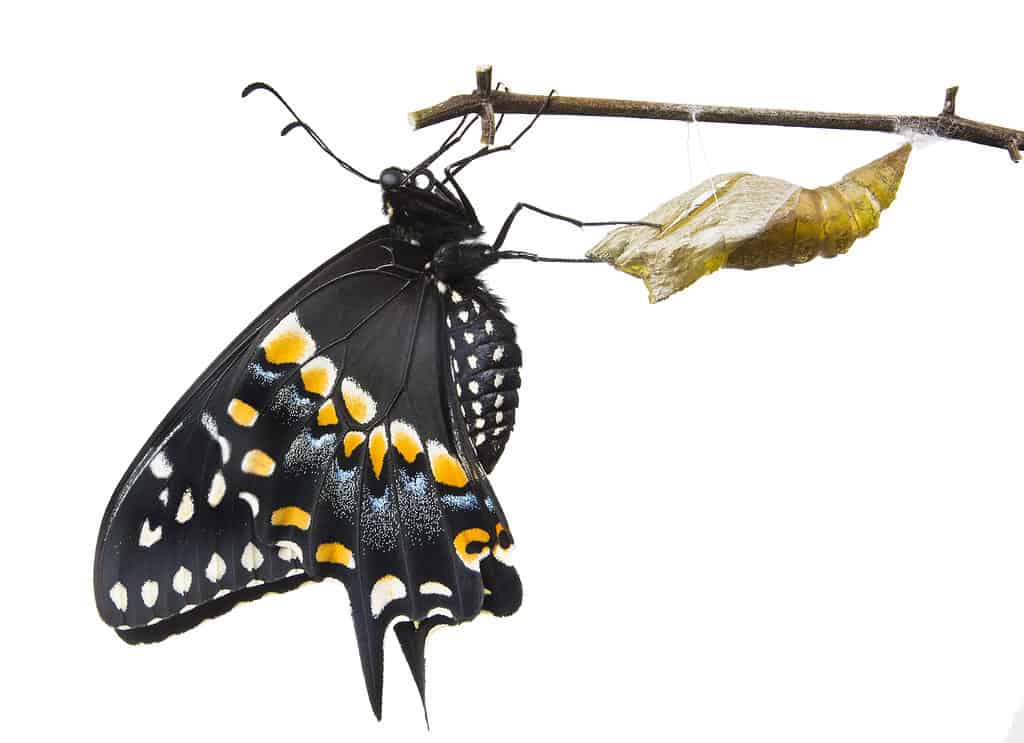
Inside the chrysalis, the caterpillar becomes a pupa before undergoing metamorphosis and emerging as an adult butterfly.
©IrinaK/Shutterstock.com
Diet
Swallowtail caterpillars are herbivores and primarily feed on the leaves of plants from the family Apiaceae, which includes parsley, fennel, dill, and wild carrot. They are known to be quite selective in their diet and may only feed on certain species of plants within this family. They have also been known to feed on plants from the families Rutaceae and Umbelliferae. As they grow and develop, they may also consume more leaves from the host plant. Once they reach maturity, they will form a chrysalis and eventually emerge as adult swallowtail butterflies
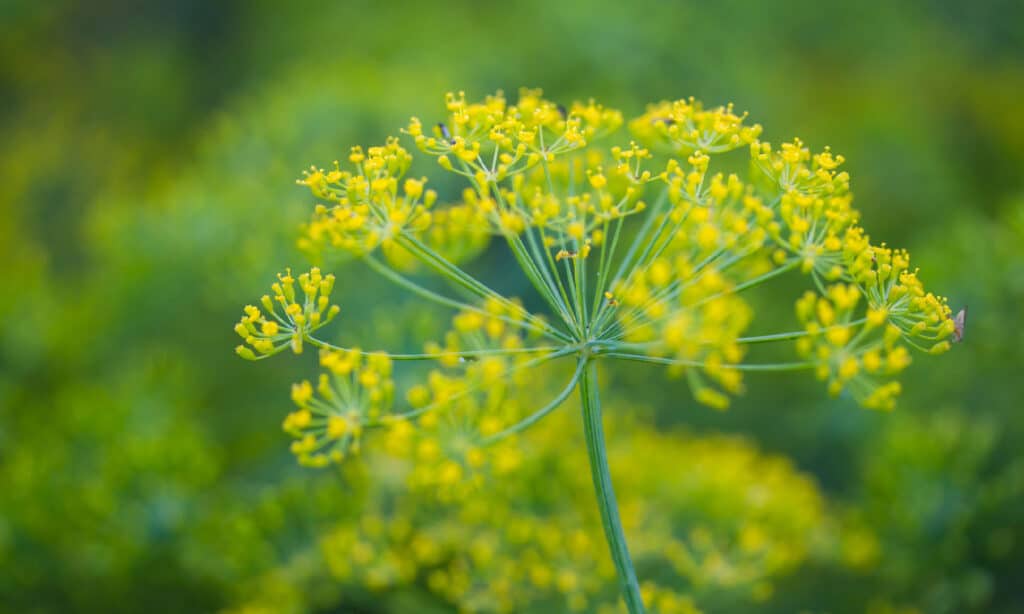
Swallowtail caterpillars are picky eaters, but they like fennel (pictured).
©iStock.com/AnnaDudek
Population
Population numbers for specific species of swallowtail caterpillars can be difficult to determine and can fluctuate greatly from year to year due to various factors such as weather, predators, habitat decline, and disease.
Swallowtail caterpillars are the larval stage of swallowtail butterflies. They are typically green, yellow, black, or brown in color. Plants such as parsley, dill, and fennel make up the lion‘s share of their diet. They go through several stages before pupating and eventually emerging as adult butterflies.
Up Next:
View all 293 animals that start with SSwallowtail Caterpillar FAQs (Frequently Asked Questions)
Where do swallowtail caterpillars live?
Swallowtail caterpillars live on every continent except for Antarctica. They can be found munching leaves on plants like parsley and fennel.
How long do swallowtail caterpillars get?
Depending on the species, swallowtail caterpillars will be between 1-3 inches long.
What are eyespots?
Eyespots are markings on swallowtail caterpillars that resemble the eyes of much larger predators. Would-be predators are deterred by eyespots, believing that they are looking at a much larger animal. Swallowtail caterpillars actually have very small eyes, about the size of a pinhole.
Are swallowtail caterpillars an endangered species?
With almost 600 different species of swallowtails, some are on the endangered list, but not all.
How many legs do swallowtail caterpillars have?
Like all incests, caterpillars have 6 legs.
Thank you for reading! Have some feedback for us? Contact the AZ Animals editorial team.
Sources
- ufl.edu, Available here: https://entnemdept.ufl.edu/creatures/bfly/bfly2/eastern_black_swallowtail.htm
- mo.gov, Available here: https://mdc.mo.gov/discover-nature/field-guide/black-swallowtail-parsnip-swallowtail
- wikipedia.org, Available here: https://en.wikipedia.org/wiki/Papilio_glaucus

















